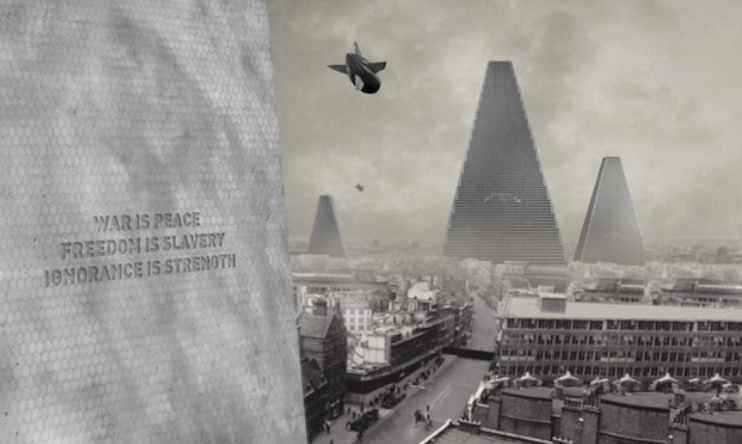
David Brussat
Modern Architecture and the Administrative State
The case against democracy for centuries was that the common man would vote himself more and more goodies paid for by taxes on his “betters.” At last, self-rule would self-destruct. The founders tried to prevent this through a republic whose Constitution set up checks, balances and other restraints on pure democracy. Originally, only one chamber of Congress - the House of Representatives - was selected by the people. The Senate was selected by each state legislature. The president is still selected not by popular vote but by the Electoral College, and classical architecture still forms the parable of our national ideals.
Now it seems that after a century of change the old fears have flipped. The elite has edited the common man out of the equation by placing the enactment of law, or rules that have the force of law, into the hands of unelected bureaucrats. These days, the federal bureaucracy is called the administrative state. Increasingly, new federal buildings challenge the symbolism of the American founding.
Our architecture may be said to track, in some degree, the evolution of our nation. In my Architecture Here and There blog and in my Traditional Architecture blog, I have occasionally observed that dystopian novels and dystopian films house good guys in traditional architecture and bad guys in modern architecture. (See “Preserve Modernism? Don’t freeze the DNA of our Blade Runner future.”). The idea is that modern architecture, toward which most people feel uneasy but which has been embraced by the 1 percent, is a metaphor for authoritarian rule.
The other day, leafing through a series of articles on Progressivism in the Claremont Review of Books, I came across some interesting quotes in “How the Ruling Class Rules,” a review by John Marini of Paul Moreno’s The Bureaucrat Kings: The Origins and Underpinnings of America’s Bureaucratic State.
Tying together some passages Moreno has selected builds up to an eerie parallel between the direction of bureaucracy and the direction of architecture. Hegel promoted the “organized intelligence” of the “rational state.” Dewey called it the “social intelligence.” Kafka warned that “every revolution evaporates and leaves behind only the slime of a new bureaucracy.” Marx called bureaucracy the “circle from which one cannot escape.” Weber foresaw in rational control the “polar night of icy darkness” and the “iron cage,” culminating in “the shell of that future bondage” and “the disenchantment of the world.”
The shell of that future bondage sure sounds like the glass and steel exoskeleton of corporate modern architecture. The warnings of philosophers and sociologists have since those days been seconded by the warnings of novelists such as Orwell and Huxley and filmmakers like George Lucas. The dark night of authoritarianism has shown itself in the architecture of the 20th and 21st centuries.
The settings of films in, for example, the James Bond and Star Wars series and their villains’ lairs often make the point clearly. I don’t know whether Ian Fleming or George Lucas consciously decided that the bad guys should plot their evil doings so predictably from the sinister settings of modernist architecture. I purposely used the word predictably because it seems reasonable to attribute the look of those lairs to the reflection in filmmakers’ minds of cultural expectations of the look of evil and hence of the places villains would naturally design for themselves.
But architecture does not just reflect culture, it generates the sensibilities that shape culture. Winston Churchill said, “We shape our buildings; thereafter, they shape us.” His idea can be rephrased to chilling effect: Our society shapes our buildings, which then shape our society. The more modern architecture arises to house our corporate and bureaucratic culture, the more its victims (us) get used to its sterility and accept the collection of data about us by the computers within. This paves the way for more erosion of the power of the people to rule themselves - not just as a society but as individuals.
The rational state, built upon organized intelligence, should not need to become a sinister thing, and that was not, supposedly, the original intent. And we can dispute the extent to which even now bureaucracy (and its handmaiden modern architecture) pose a threat to democracy. My own association of modern architecture with villainy may merely reflect the wish as father to the thought - but please, it’s not a wish, it’s a fear. I have seen enough modern architecture to think it prudent to discuss that fear.
As they say, if you see something, say something.
Next stop: the self-driving auto, courtesy of Google.
For 30 years, David Brussat was on the editorial board of The Providence Journal, where he wrote unsigned editorials expressing the newspaper’s opinion on a wide range of topics, plus a weekly column of architecture criticism and commentary on cultural, design and economic development issues locally, nationally and globally. For a quarter of a century he was the only newspaper-based architecture critic in America championing new traditional work and denouncing modernist work. In 2009, he began writing a blog, Architecture Here and There. He was laid off when the Journal was sold in 2014, and his writing continues through his blog, which is now independent. In 2014 he also started a consultancy through which he writes and edits material for some of the architecture world’s most celebrated designers and theorists. In 2015, at the request of History Press, he wrote Lost Providence, which was published in 2017.
Brussat belongs to the Providence Preservation Society, the Rhode Island Historical Society, and the Institute of Classical Architecture & Art, where he is on the board of the New England chapter. He received an Arthur Ross Award from the ICAA in 2002, and he was recently named a Fellow of the Royal Society of the Arts. He was born in Chicago, grew up in the District of Columbia, and lives in Providence with his wife, Victoria, son Billy, and cat Gato.






